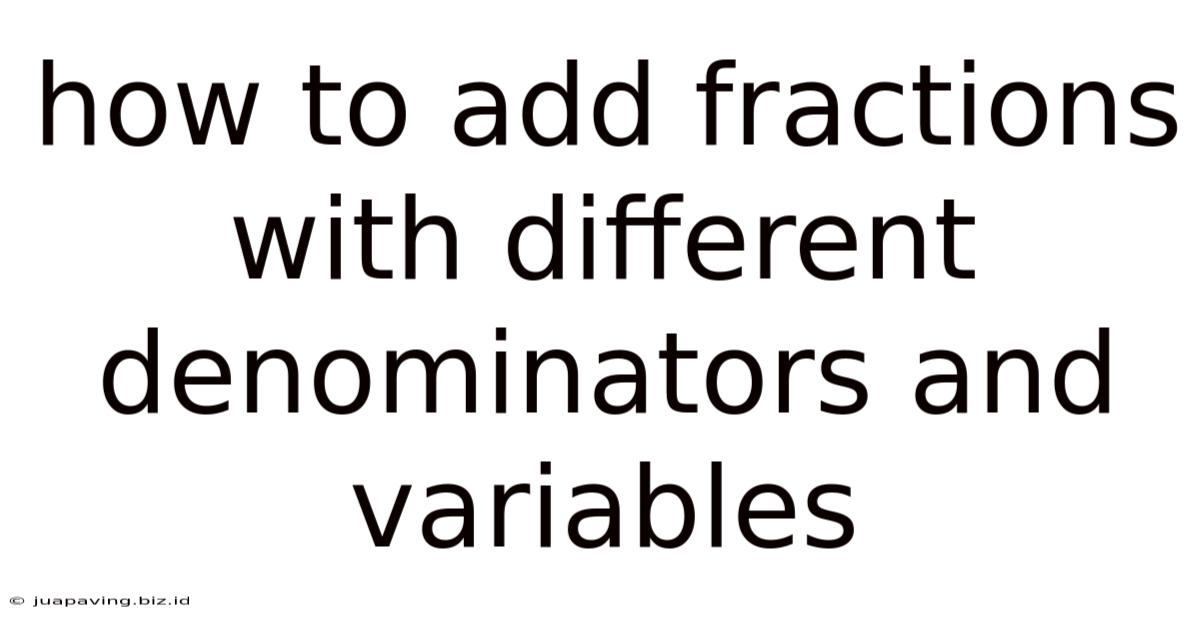How To Add Fractions With Different Denominators And Variables
Juapaving
May 25, 2025 · 5 min read

Table of Contents
How to Add Fractions with Different Denominators and Variables
Adding fractions, even those involving variables, is a fundamental skill in mathematics. While adding fractions with the same denominator is straightforward, the process becomes slightly more complex when the denominators differ, especially when variables are involved. This comprehensive guide will break down the process step-by-step, equipping you with the skills and confidence to tackle any fraction addition problem, regardless of its complexity.
Understanding the Basics of Fraction Addition
Before delving into fractions with different denominators and variables, let's review the fundamental principle of fraction addition. The core concept revolves around finding a common denominator. This is a number that is a multiple of both denominators. Once you have a common denominator, you can add the numerators and keep the denominator the same.
For example:
1/4 + 2/4 = (1+2)/4 = 3/4
Notice that the denominators are already the same. This simplifies the process significantly.
Adding Fractions with Different Denominators (No Variables)
When adding fractions with different denominators, the first step is to find the least common denominator (LCD). The LCD is the smallest number that is a multiple of both denominators. Finding the LCD is crucial for simplifying the resulting fraction.
Let's consider an example:
1/3 + 1/2
-
Find the LCD: The multiples of 3 are 3, 6, 9, 12... The multiples of 2 are 2, 4, 6, 8... The smallest number that appears in both lists is 6. Therefore, the LCD is 6.
-
Convert the fractions to equivalent fractions with the LCD:
1/3 = (1 * 2)/(3 * 2) = 2/6 1/2 = (1 * 3)/(2 * 3) = 3/6
-
Add the numerators:
2/6 + 3/6 = (2 + 3)/6 = 5/6
Therefore, 1/3 + 1/2 = 5/6
Adding Fractions with Different Denominators and Variables
Adding fractions with different denominators and variables involves the same principles, but requires a greater understanding of algebraic manipulation. The key is to find the LCD, which might now involve variables. Let's explore several scenarios:
Scenario 1: Simple Variable Denominators
Let's add x/2 + x/3
-
Find the LCD: The LCD of 2 and 3 is 6.
-
Convert the fractions:
x/2 = (x * 3)/(2 * 3) = 3x/6 x/3 = (x * 2)/(3 * 2) = 2x/6
-
Add the numerators:
3x/6 + 2x/6 = (3x + 2x)/6 = 5x/6
Scenario 2: Polynomial Denominators
Adding fractions with polynomial denominators requires factoring the denominators to find the LCD. Consider the example:
1/(x+1) + 2/(x-1)
-
Find the LCD: The denominators are already factored. The LCD is (x+1)(x-1).
-
Convert the fractions:
1/(x+1) = (x-1)/((x+1)(x-1)) 2/(x-1) = 2(x+1)/((x+1)(x-1))
-
Add the numerators:
(x-1)/((x+1)(x-1)) + 2(x+1)/((x+1)(x-1)) = (x - 1 + 2x + 2)/((x+1)(x-1)) = (3x + 1)/((x+1)(x-1))
Scenario 3: More Complex Polynomial Denominators
Let's consider a more involved example:
3/(x²+2x) + 1/(x+2)
-
Factor the denominators: x²+2x = x(x+2). The denominator x+2 is already factored.
-
Find the LCD: The LCD is x(x+2).
-
Convert the fractions:
3/(x(x+2)) = 3/(x(x+2)) (already in the correct form) 1/(x+2) = x/(x(x+2))
-
Add the numerators:
3/(x(x+2)) + x/(x(x+2)) = (3 + x)/(x(x+2))
Scenario 4: Fractions with Variables in Both Numerator and Denominator
Consider the example:
(2x + 1)/x + (x - 1)/(2x)
-
Find the LCD: The LCD is 2x.
-
Convert the fractions:
(2x + 1)/x = 2(2x + 1)/(2x) = (4x + 2)/(2x) (x - 1)/(2x) = (x - 1)/(2x) (already in the correct form)
-
Add the numerators:
(4x + 2)/(2x) + (x - 1)/(2x) = (4x + 2 + x - 1)/(2x) = (5x + 1)/(2x)
Simplifying the Resulting Fraction
After adding the fractions, always simplify the resulting fraction by canceling common factors in the numerator and denominator. This is particularly important when dealing with variables. For example, if you end up with (x² + 2x)/x, you can simplify this to x + 2 (assuming x ≠ 0).
Common Mistakes to Avoid
-
Forgetting to find the LCD: This is the most common mistake. Always ensure you find the LCD before attempting to add the fractions.
-
Incorrectly converting fractions: When converting fractions to equivalent fractions with the LCD, ensure you multiply both the numerator and denominator by the same factor.
-
Errors in algebraic manipulation: When dealing with variables, carefully perform algebraic operations like factoring, expanding, and simplifying.
-
Not simplifying the final answer: Always simplify the final fraction by canceling common factors.
Practical Applications
Adding fractions with different denominators and variables is a crucial skill in various mathematical fields, including:
- Algebra: Solving equations and inequalities involving fractions.
- Calculus: Evaluating limits, derivatives, and integrals.
- Physics and Engineering: Formulating and solving equations related to motion, forces, and circuits.
Mastering this skill will significantly improve your ability to solve complex mathematical problems. Remember to practice regularly and gradually increase the difficulty of the problems you tackle. The more you practice, the more confident and proficient you will become in adding fractions with different denominators and variables. This process, while requiring careful attention to detail, is fundamental for success in higher-level mathematics and its applications. By understanding the steps and common pitfalls outlined above, you'll be well-equipped to handle any fraction addition challenge.
Latest Posts
Latest Posts
-
Exercise 13 Neuron Anatomy And Physiology
May 25, 2025
-
Which Of The Following Is True About Stress
May 25, 2025
-
The Consumer Decision Process Model Represents
May 25, 2025
-
Boy I Cant Believe It Is Almost October
May 25, 2025
-
Summary Of Jekyll And Hyde Chapter 1
May 25, 2025
Related Post
Thank you for visiting our website which covers about How To Add Fractions With Different Denominators And Variables . We hope the information provided has been useful to you. Feel free to contact us if you have any questions or need further assistance. See you next time and don't miss to bookmark.